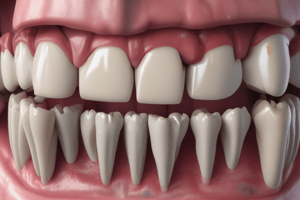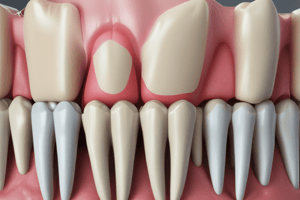Podcast
Questions and Answers
What is the primary function of cementum related to the periodontal ligament?
What is the primary function of cementum related to the periodontal ligament?
- To anchor the tooth to the bone (correct)
- To facilitate tooth movement
- To provide nutrition to the root
- To enhance tooth color
What is the function of the alveolar process?
What is the function of the alveolar process?
- Functions as a unit and is tooth dependent (correct)
- Remains static regardless of tooth health
- Acts solely as a support structure for gums
- Directly influences tooth mobility
What type of cementum is formed primarily during the eruption of the tooth?
What type of cementum is formed primarily during the eruption of the tooth?
- Cementum with Sharpey’s fibres
- Acellular cementum
- Cellular/secondary cementum (correct)
- Primary cementum
Which component does NOT form part of the alveolar process?
Which component does NOT form part of the alveolar process?
What is the role of the alveolar process?
What is the role of the alveolar process?
What occurs to the alveolar process when teeth are lost?
What occurs to the alveolar process when teeth are lost?
Which characteristic of cementum contributes to maintaining the integrity of the tooth under orthodontic forces?
Which characteristic of cementum contributes to maintaining the integrity of the tooth under orthodontic forces?
Where does the alveolar crest typically lie in a healthy situation?
Where does the alveolar crest typically lie in a healthy situation?
How does cementum help with occlusal relationships?
How does cementum help with occlusal relationships?
What is true about the trabecular bone in the mandible compared to the maxilla?
What is true about the trabecular bone in the mandible compared to the maxilla?
What is the primary function of the masticatory mucosa?
What is the primary function of the masticatory mucosa?
Which type of mucosa covers areas such as the lips and the floor of the mouth?
Which type of mucosa covers areas such as the lips and the floor of the mouth?
What is the role of the periodontal ligament?
What is the role of the periodontal ligament?
What distinguishes the free marginal gingiva from attached gingiva?
What distinguishes the free marginal gingiva from attached gingiva?
Which of the following is NOT a component of the periodontal ligament?
Which of the following is NOT a component of the periodontal ligament?
What function do the major fiber bundles of the gingiva serve?
What function do the major fiber bundles of the gingiva serve?
Which part of the gingiva is described as being potentially stippled?
Which part of the gingiva is described as being potentially stippled?
What type of nerves are found within the periodontal ligament?
What type of nerves are found within the periodontal ligament?
How does the periodontal ligament respond to forces applied to teeth?
How does the periodontal ligament respond to forces applied to teeth?
What separates the root surface from the alveolar bone?
What separates the root surface from the alveolar bone?
What type of mucosa primarily consists of taste buds?
What type of mucosa primarily consists of taste buds?
The alveologingival fiber bundles serve which purpose?
The alveologingival fiber bundles serve which purpose?
Which region does NOT contain keratinized tissue?
Which region does NOT contain keratinized tissue?
What factors can influence the width of the periodontal ligament?
What factors can influence the width of the periodontal ligament?
Flashcards are hidden until you start studying
Study Notes
Periodontal Anatomy and Function
- Periodontal disease involves the supporting structures around the teeth.
- The term ‘periodontal’ refers to the tissues surrounding the teeth; "peri" means around, and "odont" means tooth.
- The periodontium serves to attach teeth to the alveolar bone, supporting masticatory functions and accommodating lateral movements.
Tissues of the Periodontium
- Composed of soft tissues in the oral cavity including:
- Oral Mucosa: A moist membrane lining the inside of the mouth.
- Masticatory Mucosa: 25% of total oral mucosa; found in hard palate and gingiva, attached to the underlying bone.
- Specialized Mucosa: 15% of oral mucosa; located on the dorsum of the tongue with numerous taste buds for taste sensation.
- Lining Mucosa: 60% of total oral mucosa; includes structures like lips and soft palate, is movable, non-keratinized, and flexible.
- Oral Mucosa: A moist membrane lining the inside of the mouth.
Gingiva Structure and Functions
- Visible part of the oral cavity; covers the teeth at or above the cemento-enamel junction (CEJ).
- Morphological divisions include:
- Free (Marginal) Gingiva: Not attached, surrounds the tooth.
- Attached Gingiva: Firmly bound to the underlying bone.
- Interdental Papillae: Fills the gaps between teeth.
- Functions to attach dental hard tissues to the oral mucosa and protect periodontal tissues from bacteria.
Fibre Bundles in Gingiva
- Five main fibre bundles provide support and connection:
- Dentogingival: Supports free and attached gingiva.
- Alveologingival: Attaches gingiva to the alveolar bone.
- Dento-periosteal: Provides anchorage from cementum to bone crest.
- Circular group: Encircles the tooth for additional support.
- Transeptal group: Connects adjacent teeth.
Periodontal Ligament (PDL)
- Specialized connective tissue attaching tooth roots to alveolar bone.
- Consists of collagen fibres, blood vessels, lymphatics, and nerves, typically measuring 0.2 mm in width.
- Functions include:
- Tooth mobility, anchorage, shock absorption, and sensation (touch, pain, proprioception).
Cementum
- Mineralized tissue covering tooth roots; less resorbed than bone.
- Contains Sharpey's fibres anchoring PDL to the root surface; avascular and can regenerate.
- Functions include anchorage, maintenance of PDL width, and repair of root fractures.
Alveolar Bone
- Thickened ridge containing tooth sockets; specialized structure supports teeth.
- Comprises three components:
- Alveolus/cribriform plate (tooth socket)
- Compact bone (facial and lingual plates)
- Trabecular bone (marrow bone between plates).
- Constantly remodels in response to physiological stress, maintaining relationships with adjacent structures.
General Characteristics of Periodontium
- Periodontal structures are intricately linked, serving to maintain tooth integrity, support function, and adapt to various mechanical stresses.
- Healthy alveolar crest is typically located 2-3 mm apical to the CEJ, with bone remodeling being a normal process influenced by activity and stress levels.
Studying That Suits You
Use AI to generate personalized quizzes and flashcards to suit your learning preferences.




